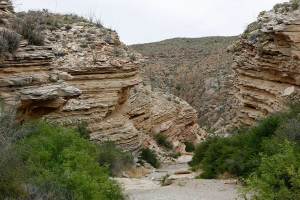At a glance
Distance: 1.25 miles roundtrip
Elevation change: 125 feet
Hiking time: 30 minutes
Highlights: Colorful layers of sculpted rock frame a canyon that leads to an oasis that is one of the few places in the park that is always wet.
Difficulty: ★★☆☆☆
A leisurely walk up a dry wash with some clambering involved if you push farther up the canyon.
Trail conditions: ★★★★☆
The flat trail wanders a bit at first near the wash, but you can’t get lost.
Scenery: ★★★★☆
Walls of sharply tilting limestone give way to the smooth pastels of the canyon floor surrounding the tinaja.
Solitude: ★★★☆☆
The ruggedness of the Ore Road cuts down on the traffic for an otherwise easy trail.
Other reviews
• Ernst Tinaja at Trails.com
• The trail in photos
• Geology of the canyon.
The landscape is a scrubby desert in the shadow of the Dead Horse Mountains, punctuated with cactus flowers in the spring. Because it is one of the few places in the park where there is always water, the tinaja attracts a diversity of thirsty wildlife.
The trail crosses a stream bed at its outset and then wanders a bit along a rocky, gravel wash, but there’s little danger of losing your way. You can follow either the trail or the wash itself, because they converge in the same place. Ahead of the tinaja, colorful layered walls of uplifted and twisted limestone loom on either side of the wash. The tinaja itself is carved into the older white limestone of the canyon floor, worn smooth by the flood that sweeps the canyon when it rains.
The terrain once was the floor of a shallow sea that inundated what is now Big Bend National Park long before the volcanic activity that built the Chisos Mountains.
The big tinaja, along with a few smaller siblings that are often bone dry, are framed by the canyon walls as they narrow at the end of the trail.
The cake layers of rock surrounding the tinaja enable you to clamber around to its opposite side for a view of the deep pool with the canyon’s cathedral walls in the background. The same roaring waters that carved the tinaja have polished the surrounding rock, making the drop down to the edge of the tinaja itself a bit hazardous.
Beyond the tinaja the canyon climbs more steeply, and the way is blocked by boulders and slickrock, but if you’re game, the canyon continues with spectacular rocky views.
• • •








